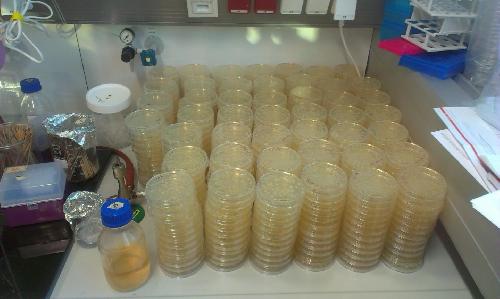Bacteria and other prokaryotes have been around for billions of years because they managed to develop successful evolutionary strategies for survival. For instance, they possess defense mechanisms that allow them to discriminate between self and non-self DNA in the event of a virus infection. These defense mechanisms are called restriction-modification systems and are based on the balance between the two enzymes M (methyltransferase) and R (restriction endonuclease). M tags endogenous DNA as self by methylating short specific DNA sequences--called restriction sites, and R recognizes unmethylated restriction sites as non-self and cleaves the DNA to render it harmless.
It has been suspected that the discrimination mechanism of restriction-modification systems may be imperfect and that also bacteria may experience autoimmunity issues because the number of restriction sites in many bacterial genomes is lower than expected. On the upside of potential mistakes, occasional cleavage of self-DNA could promote DNA recombination and contribute to genetic variation in microbial populations, thus facilitating adaptive evolution. On the downside however, it might lead to cell death and thus impose a fitness cost on bacterial populations. Despite these potential implications, autoimmunity in bacteria has not been directly observed so far.
 These are Escherichia coli colonies. Credit: © IST Austria, 2016
These are Escherichia coli colonies. Credit: © IST Austria, 2016
Maros Pleska, a graduate student in the laboratory of C?lin Guet, an Assistant Professor at IST Austria, together with the teams of their colleagues Edo Kussell of New York University and Yuichi Wakamoto of Tokyo University, as well as IST Austria postdoc Tobias Bergmiller examine this scenario in their paper published on January 21, 2016, in Current Biology.
The authors studied two different restriction-modification systems originating from the bacterium Escherichia coli, named EcoRI and EcoRV (pronounced as "eco R one" and "eco R five"). Pleska and his colleagues analyzed populations as well as single cells carrying these restriction-modification systems and found that EcoRI is indeed prone to erroneously cleave self DNA while EcoRV is not. These autoimmune events are very rare and easily masked by the majority of unaffected cells, which is why, up until now, detection of bacterial autoimmunity was a major experimental challenge.
The authors managed to spot the rare events of bacterial autoimmunity and show that when they occur, the SOS response is triggered and specific proteins disengage to repair the damaged DNA. By comparing and counting nearly one hundred thousand bacterial colonies (see picture), the authors found out that under standard conditions, everything works just fine, but the ability to fix the damage is decreased in conditions where resources are scarce.
But why are some restriction-modification systems more likely to cause autoimmunity than others? Guet and his team found that the probability of cleaving self DNA is higher for more efficient restriction-modification systems--in this case EcoRI. It almost seems as if these systems are overeager at times in their attempt to protect the cell from harm. The result suggests the existence of an evolutionary tradeoff between enhanced protection against exogenous DNA and increased autoimmunity.
The autoimmunity work would not have been possible without the highly interdisciplinary team from Austria, Japan and USA, which was supported by a Young Investigator Human Frontier Science Grant to Guet, Kussell and Wakamoto that specifically supports high risk interdisciplinary projects, as well as a DOC OeAW Fellowship awarded to Pleska.
source: Institute of Science and Technology Austria